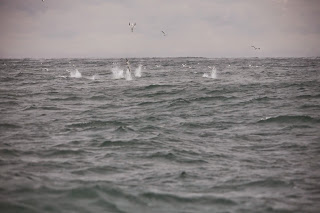I became obsessed with finding razorbills. They are a strange little black and white bird related to puffins. They sort of look like flying penguins. Anyway, the migration of these guys is usually at its peak on the Outer Banks around Valentine's Day, so I booked a pelagic tour that took off from Hatteras Village.
The boat ended up going about 15 miles offshore. It was bitterly cold, but I was able to take pictures of Brown Pelicans and Northern Gannets almost immediately. The gannets along with a myriad of gulls followed the boat for the entire trip.
About two hours in, I spotted my first razorbill. The first picture I took was awful; they beat the air very frantically in an attempt to take off and my first attempted image was very blurry. Thankfully, we saw over a hundred of them, so I got plenty of practice in photographing them.
Along with razorbills, we spotted dovekies, another alcid related to puffins. They look pretty much the same as razorbills but they are TINY. They are usually roughly half the size of puffins, with their wingspans generally not reaching larger than 15 inches. They are difficult to photograph because of the size, but also because they startle incredibly easy.
A first for the boat I was on was a Harlequin Duck and a Great Skua, which is apparently a very rare bird. I didn't get great pictures of either, but the experience was pretty neat. The crowning moment of the trip however, was in the late afternoon as we were preparing to head back inland. We came across quite a large group of Northern Gannets, probably more than 200. And they all started to dive. It was spectacular. Gannets climb in the air 50-100 feet looking for fish. When they find the fish, they dive down and nab them in their beaks. Their faces are specially designed to withstand hitting the water at such high speeds, and their wings when diving are reminiscent of a bird of prey diving. It was amazing to watch these birds hit the water in droves with sea smoke coming off the water.
I was also able to venture around Cape Hatteras a bit and scope out the other birds that winter in the area. There were so many egrets and snow geese! I followed a flock of Redhead Ducks around for a few hours and was lucky enough to spot a Ringneck Duck and a Hooded Merganser in the area as well. The terns were out in full force and I was treated to a show at a secluded pond where they were diving to catch small fish less than 10 feet from where I was standing. It was a pretty spectacular weekend in the bird watching department, and I had a great time regardless of the humid cold.
 |
| Tern |
 |
| Redheads |
 |
| Hooded Merganser |
 |
| Ringneck |
In case you may have noticed from this blog post, I have gone a bit bird centric over the last few months. I'm very excited to show work from my latest gum bichromate project which I will probably be posting at the end of this week or beginning of next. I have been working very hard on this series and I'm finally ready to share the beginning of it with the internet world.
















